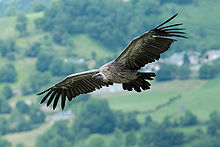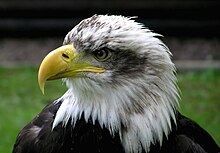Bird of prey

Birds of prey are birds that hunt for food primarily on the wing, using their keen senses, especially vision. They are defined as birds that primarily hunt vertebrates, including other birds. Their talons and beaks tend to be relatively large, powerful and adapted for tearing and/or piercing flesh. In most cases, the females are considerably larger than the males. The term "raptor" is derived from the Latin word rapere (meaning to seize or take by force) and may refer informally to all birds of prey, or specifically to the diurnal group.[1] Because of their predatory lifestyle, often at the top of the food chain, they face distinct conservation concerns.
Many species of bird may be considered partly or exclusively predatory; however, in ornithology the term "bird of prey" applies only to birds of the families listed below.
Definition
Taken literally the term "bird of prey" has a wide meaning that includes many birds that hunt and feed on animals and also birds that eat very small insects.[2] In ornithology, and the definition used here, the term has a narrower meaning for birds that have very good eyesight for finding food, strong feet for holding food, and a strong curved beak for tearing flesh.[3] Most birds of prey also have strong curved talons for catching or killing prey.[3] Birds of prey generally prey on vertebrates, which are usually quite large relative to the size of the bird.[2] Most also eat carrion at least occasionally and the vultures and condors eat carrion as their main food source.[3] By way of an example, the narrower definition excludes storks and gulls, which can eat quite large fish, partly because these birds catch and kill prey entirely with their beaks,[2] and similarly bird-eating skuas, fish-eating penguins, and vertebrate-eating kookaburras are excluded.
Using this cluster of anatomical and behavioural features, the species listed below are usually known to be birds of prey in ornithology. They can be divided into species that hunt during daylight, the raptors, and into species that hunt during the night, the owls. The raptors and the owls are distantly related and are classified in separate orders; however, their evolution has been convergent, both groups of birds adapting to a predatory lifestyle.[2]
Classification by ancestry

The diurnal birds of prey are formally classified into five families (traditionally of the order Falconiformes, a classification currently[vague] in flux):
- Accipitridae: hawks, eagles, buzzards, harriers, kites and Old World vultures
- Pandionidae: the Osprey (sometimes classified as subfamily Pandioninae of the previous family)
- Sagittariidae: the Secretary Bird
- Falconidae: falcons and caracaras
- Cathartidae: New World vultures including condors.
The nocturnal birds of prey – the owls – are classified separately as members of two extant families of the order Strigiformes:
The observation that otherwise unrelated bird groups may perform similar ecological roles and bear striking morphological similarities to one another is explained by the concept of convergent evolution.
Common names
The common names for various birds of prey are based on structure but many of the traditional names do not reflect the evolutionary relationships between the groups.

- Eagles tend to be large birds with long, broad wings and massive feet. Booted Eagles have legs and feet feathered to the toes and build very large stick nests.
- Ospreys, a single species found worldwide that specializes in catching fish, and builds large stick nests.
- Kites have long wings and relatively weak legs. They spend much of their time soaring. They will take live vertebrate prey but mostly feed on insects or even carrion.
- The true Hawks are medium-sized birds of prey that usually belong to the genus Accipiter (see below). They are mainly woodland birds that hunt by sudden dashes from a concealed perch. They usually have long tails for tight steering.
- Buzzards are medium-large raptors with robust bodies and broad wings, or, alternatively, any bird of the genus Buteo (also commonly known as "hawks" in North America).
- Harriers are large, slender hawk-like birds with long tails and long thin legs. Most use a combination of keen eyesight and hearing to hunt small vertebrates, gliding on their long broad wings and circling low over grasslands and marshes.
- Vultures are carrion-eating raptors of two distinct biological families, each occurring in only the Eastern Hemisphere (Accipitridae) or the Western (Cathartidae). Members of both groups have heads either partly or fully devoid of feathers.
- Falcons are medium-size birds of prey with long pointed wings. Unlike most other raptors, they belong to the Falconidae, rather than the Accipitridae. Many are particularly swift flyers. Instead of building their own nests, falcons appropriate old nests of other birds, but sometimes they lay their eggs on cliff ledges or in tree hollows. Caracaras are a distinct subgroup of the Falconidae unique to the New World, and most common in the Neotropics – their broad wings, naked faces and appetites of a generalist suggest some level of convergence with either the Buteos or the vulturine birds, or both.
- Owls are variable-sized, typically night-specialized hunting birds. They fly almost silently due to special feather structure to reduce turbulence. They have particularly acute hearing.
See Also
References
- ^ Brown, Leslie (1997). Birds of Prey. Chancellor Press. ISBN 185152732X.
- ^ a b c d Burton, Philip (1989). Birds of Prey. illustrated by Boyer, Trevor; Ellis, Malcolm; Thelwell, David. Gallery Books. p. 8. ISBN 0831763817.
- ^ a b c Perrins, Christopher, M; Middleton, Alex, L. A., eds. (1984). The Encyclopaedia of Birds. Guild Publishing. p. 102.
{{cite book}}: CS1 maint: multiple names: editors list (link)
- Remsen, J. V., Jr., C. D. Cadena, A. Jaramillo, M. Nores, J. F. Pacheco, M. B. Robbins, T. S. Schulenberg, F. G. Stiles, D. F. Stotz, and K. J. Zimmer. [Version 2007-04-05.] A classification of the bird species of South America. American Ornithologists' Union. Accessed 2007-04-10.
External links
- Birds of Prey Classic Collection of North American Birds / CCNAB
- North American Falconers' Exchange-Falconry Forum
- Explore Birds of Prey with The Peregrine Fund
- Birds of Prey on the Internet Bird Collection
- Bird of Prey Pictures
- Global Raptor Information Network
- The Arboretum at Flagstaff's Wild Birds of Prey Program
- Raptor Resource Project
- Owls pages
